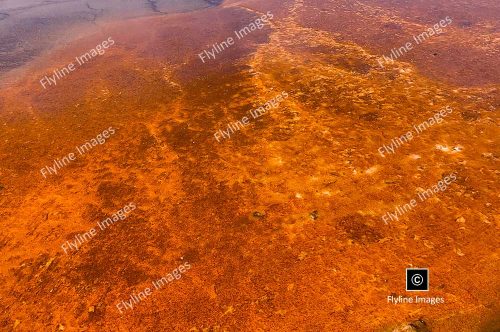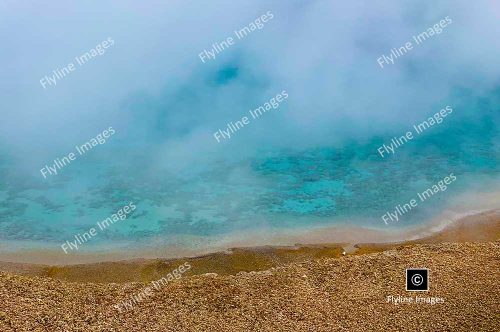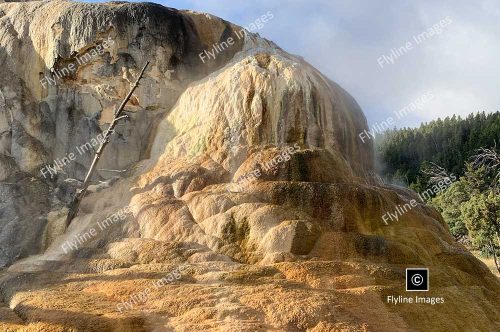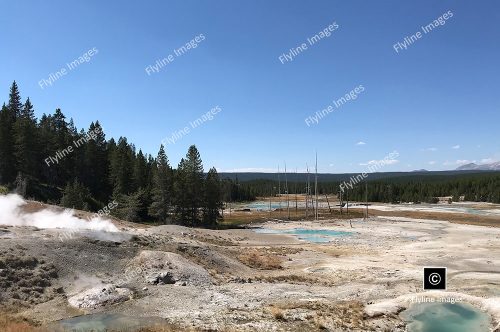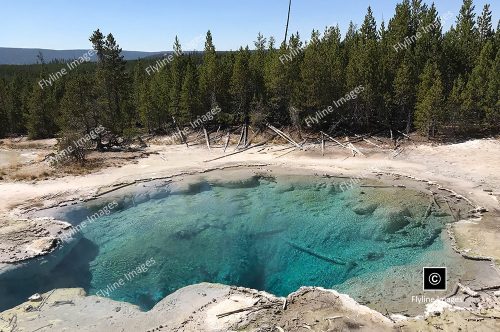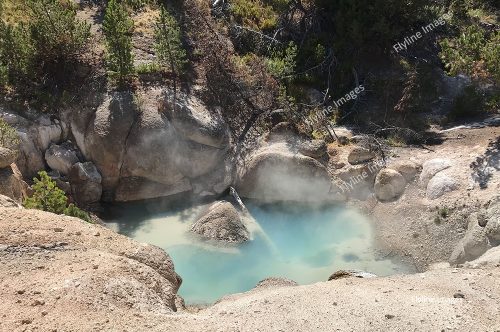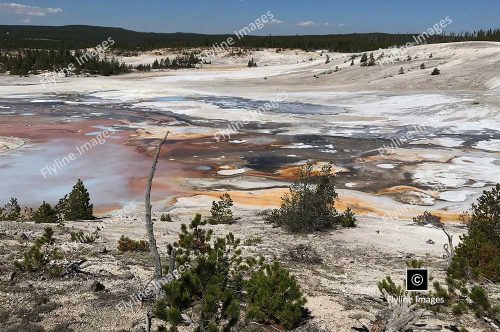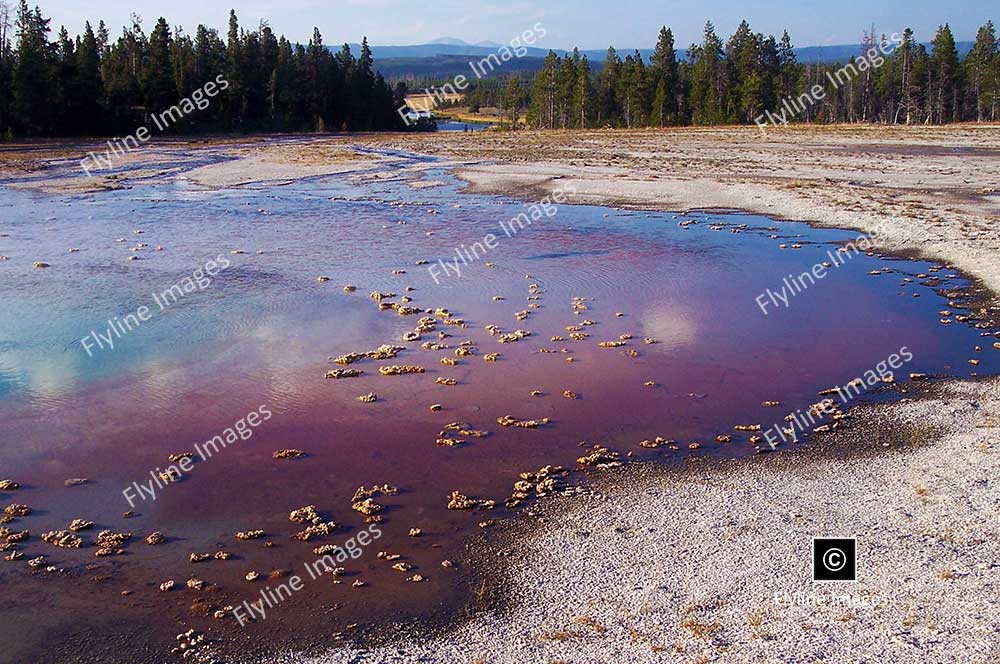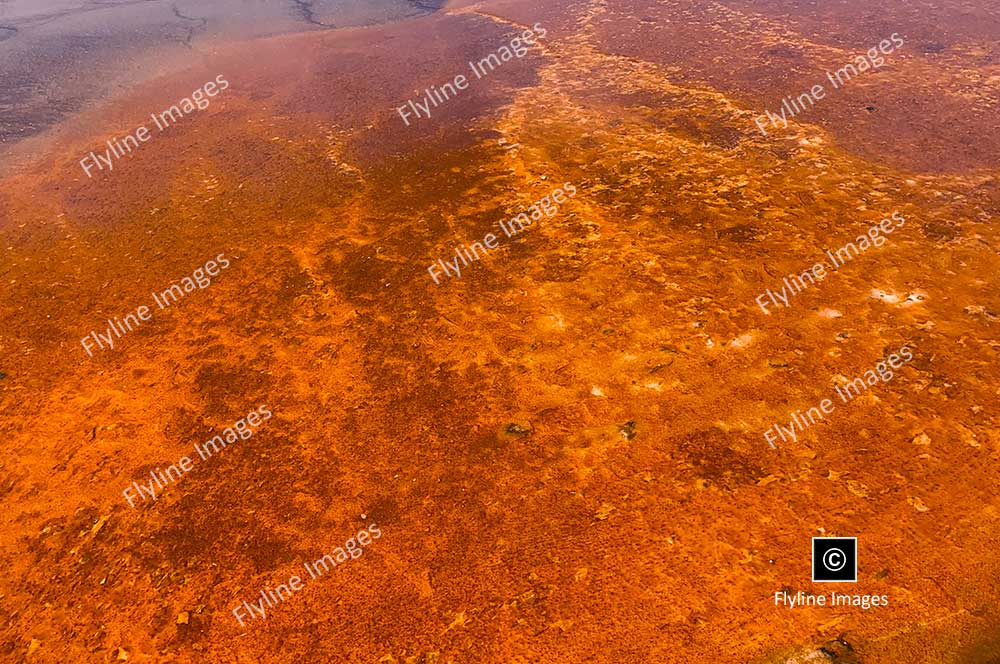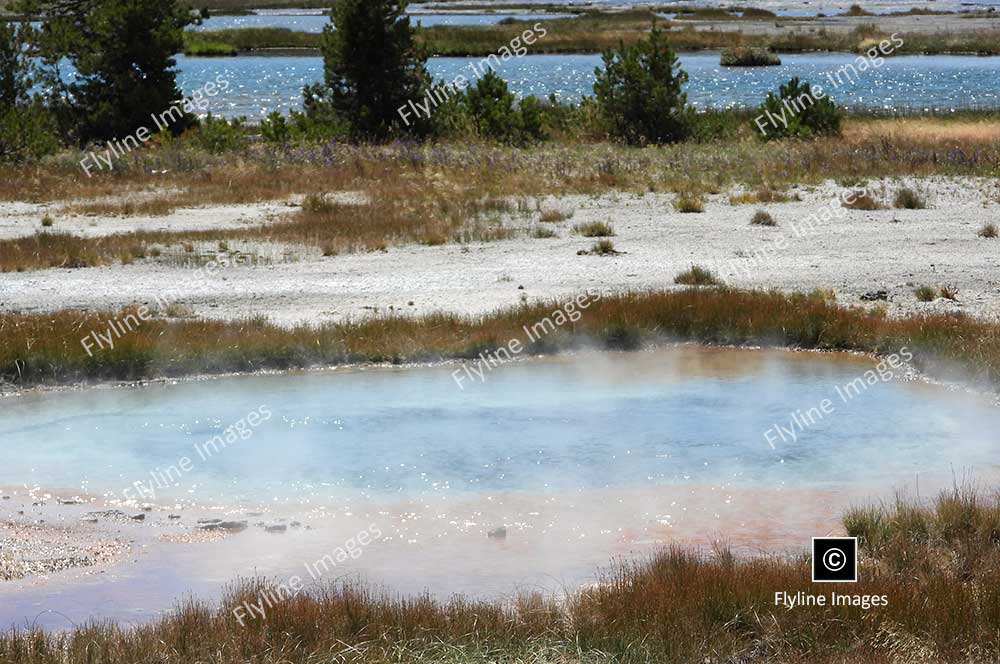Geothermal Features
Fumaroles, Geysers, Hot Springs, Mud Pots
Yellowstone National Park, renowned for its stunning natural beauty, is home to an impressive collection of geothermal features. This includes more than 10,000 hydrothermal sites, among which are over 500 geysers. Yellowstone boasts the highest concentration of geysers in the world, including the iconic Old Faithful. Additionally, the park is dotted with hot springs, mudpots, and fumaroles, each contributing to the unique and diverse ecosystem. The vibrant colors seen in many of the hot springs are due to thermophilic bacteria, which thrive in the boiling temperatures. These geothermal wonders are powered by the Yellowstone Caldera, the largest supervolcano on the continent, which lies just beneath the park’s surface, fueling its remarkable thermal activity. In 2024, there was a geothermal explosion at one of the hot springs in Biscuit Basin. We provided several photos of the geothermal area taken August of 2024, post explosion.
Portrait Style Images
More About Fumaroles, Geysers, Hot Spring, Mud Pots and Steam Vents
Fumaroles, geysers, hot springs, mud pots, and steam vents are fascinating natural phenomena that occur as a result of the Earth’s geothermal activity. Fumaroles are openings in the planet’s crust that emit steam and gases, often found near volcanic areas. Geysers are a rare spectacle, created when underground water is heated by geothermal heat, resulting in a dramatic explosion of water and steam from the Earth’s surface. Hot springs, on the other hand, are pools of geothermally heated water that rise to the surface, creating a natural spa-like experience. Mud pots form when hot water combines with volcanic ash, hydrogen sulfide gas, and ground rock to create bubbling mud, while steam vents, or solfataras, release pure steam from the Earth’s heated interior. Each of these phenomena showcases the incredible power and heat lurking beneath the Earth’s surface, providing unique opportunities for scientific study and ecotourism.
Fumaroles, geysers, hot springs, mud pots and steam vents have long fascinated scientists and tourists alike. They not only offer a glimpse into the Earth’s inner workings but also provide a unique opportunity to witness the power of nature firsthand.
One of the most interesting aspects of these geothermal features is their unpredictable nature. While some may be active for decades or even centuries, others may suddenly cease to exist due to changes in the Earth’s crust or volcanic activity. This ever-changing dynamic makes them all the more intriguing and worth studying.
In addition to their scientific significance, these natural phenomena also hold cultural and spiritual importance for many indigenous communities. They have been used for medicinal purposes, rituals and ceremonies, as well as a source of inspiration and storytelling.
Despite their awe-inspiring nature, it’s important to remember that fumaroles, geysers, hot springs, mud pots and steam vents are also fragile ecosystems. They support a unique array of microorganisms that have adapted to survive in extreme conditions. Therefore, it is crucial to protect and preserve these areas for scientific research and future generations to enjoy.
Overall, fumaroles, geysers, hot springs, mud pots and steam vents are not only natural wonders but also valuable resources for scientific study and ecotourism. As we continue to learn more about these geothermal features, we deepen our understanding of the Earth’s complex systems and appreciate the beauty and power of our planet. So let’s continue to marvel at these marvels of nature and appreciate the incredible processes that have shaped our world. Let’s also strive to protect and preserve them for future generations to experience and learn from. The more we understand and appreciate these geothermal features, the better equipped we will be to coexist with the Earth’s dynamic forces.
 Geothermal Explosion At Biscuit Basin 2024
Geothermal Explosion At Biscuit Basin 2024
Biscuit Basin, located in Yellowstone National Park, underwent a significant transformation following the explosion of 2024. The explosion, a rare geothermal event, dramatically altered the landscape of the basin. Before the explosion, Biscuit Basin was known for its stunning hot springs, geysers, and the preserved silica deposits resembling biscuits that gave the area its name. Post-explosion, the basin’s geothermal features have changed sizably, with new hot springs emerging and others vanishing or becoming more volatile. This incident resulted in increased scientific interest as researchers studied the effects on the park’s geothermal activities and the ecosystem. Despite the changes, Biscuit Basin continues to attract visitors, offering a glimpse into the dynamic and ever-changing nature of Yellowstone’s geothermal landscape.
The explosion of 2024 not only altered the physical appearance of Biscuit Basin but also raised questions about the safety and management of Yellowstone’s geothermal areas. The incident sparked discussions about the potential hazards posed by these natural phenomena and the need for increased monitoring and precautions in high-risk areas. As a result, stricter regulations were implemented to ensure visitor safety while still allowing them to experience the unique geological wonders of Yellowstone.
In addition to the changes in its geothermal features, Biscuit Basin has also seen a shift in its flora and fauna following the explosion. Some plants have struggled to adapt to the new conditions, while others have thrived in this evolving environment. Wildlife behavior has also been affected, with some species being displaced or adjusting to new food sources. This has created an opportunity for ongoing research and observation in the basin, providing valuable insights into the impact of natural disasters on ecosystems.
Despite the challenges brought by the explosion, Biscuit Basin remains a popular destination for tourists, offering a mix of old and new geothermal features to explore. Visitors can still marvel at the vibrant colors of Grand Prismatic Spring and witness eruptions from fan-favorite geysers such as Sapphire Pool and Mustard Spring. The basin also serves as a reminder of the ever-changing nature of our planet and showcases the resiliency of both nature and humans in adapting to these changes.
As we continue to learn more about the effects of the 2024 explosion, Biscuit Basin stands as a testament to the power and unpredictability of geothermal activity. It serves as a reminder that while we may try to control and understand our natural surroundings, nature will always have the final say. With careful management and ongoing research, we can continue to appreciate and protect these unique geological wonders for generations to come. So next time you visit Yellowstone National Park, be sure to make a stop at Biscuit Basin and witness firsthand the ever-changing beauty of our world’s geothermal features. A truly unforgettable experience awaits you in this dynamic and captivating destination.
Some additional content that could be added to this section includes further information about the specific changes observed in Biscuit Basin following the explosion, such as which hot springs disappeared or emerged, and how the overall landscape was altered. Additionally, more details about the ongoing research and monitoring efforts in the basin could be included, highlighting any significant findings or developments since the incident. It would also be interesting to discuss any initiatives taken by park officials to mitigate potential risks and ensure visitor safety in geothermal areas throughout Yellowstone. Finally, a comparison can be made between Biscuit Basin before and after the explosion, showcasing both the similarities and differences that make it a unique destination for tourists seeking a deeper understanding of our planet’s geothermal activity.
Overall, Biscuit Basin serves as a prime example of the complex and ever-changing nature of our world’s geological features. It highlights the importance of responsible tourism and preserving these natural wonders for future generations to appreciate and learn from. So next time you visit a geothermal area, take a moment to reflect on the power of these natural phenomena and how they shape our planet in ways we may never fully understand. Let Biscuit Basin be a reminder that even in the face of change, there is always beauty and wonder to be found in our dynamic Earth.




